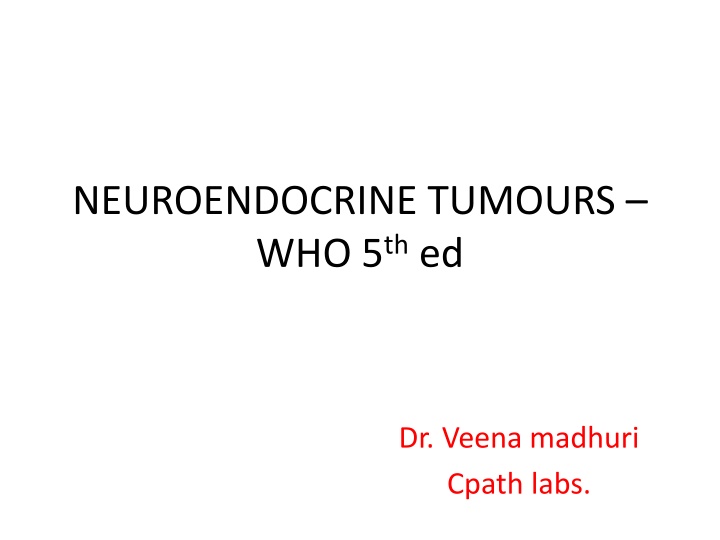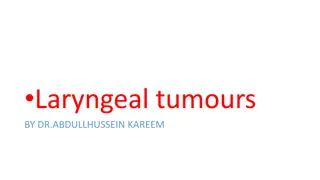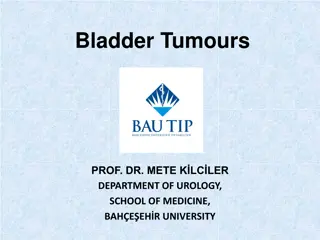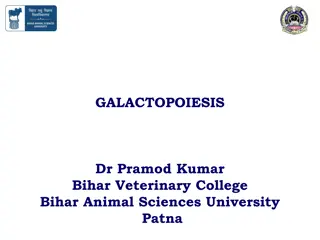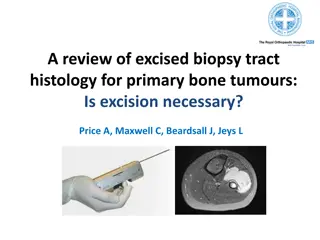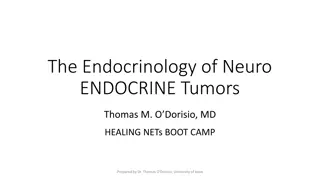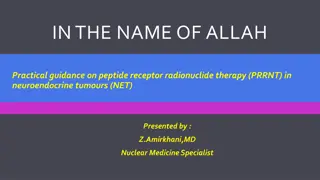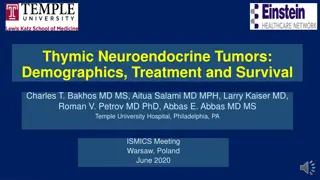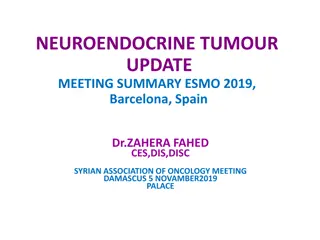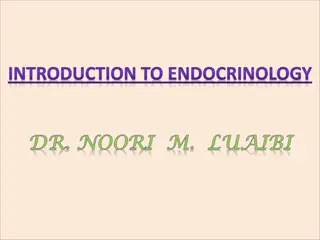Understanding Neuroendocrine Tumours WHO 5th Edition
Neuroendocrine tumours are well-differentiated epithelial neoplasms affecting endocrine and non-endocrine organs, with common sites in the lung, gastrointestinal tract, pancreas, and more. They present with hormonal or mass effects and are classified based on grading criteria. MiNENs, NEC, and PD epithelial neoplasms are also discussed, along with genetic factors and clinical implications.
Download Presentation

Please find below an Image/Link to download the presentation.
The content on the website is provided AS IS for your information and personal use only. It may not be sold, licensed, or shared on other websites without obtaining consent from the author.If you encounter any issues during the download, it is possible that the publisher has removed the file from their server.
You are allowed to download the files provided on this website for personal or commercial use, subject to the condition that they are used lawfully. All files are the property of their respective owners.
The content on the website is provided AS IS for your information and personal use only. It may not be sold, licensed, or shared on other websites without obtaining consent from the author.
E N D
Presentation Transcript
NEUROENDOCRINE TUMOURS WHO 5thed Dr. Veena madhuri Cpath labs.
Brief introduction NET malignant well differentiated epithelial neuroendocrine neoplasms. Endocrine organs - Pituitary, parathyroid, thyroid, adrenal etc. Non endocrine organs - Site of occurrence : Most commonly Lung and GI, pancreas, followed by urological , MGT, FGT, breast and skin. Head and neck Larynx Thorax Lung Digestive tract Colon/rectum, SI Urogenital - Kidney Gynaec - Ovary
Presentation : Hormonal / mass effects Etiology : MEN -1, VHL and NF and other known risk factors (FHx, age, site specific) Macro : Small polypoidal lesions to ulcerated large vascular nodules. Micro : - Islets, nests, trabeculae, ribbons, tubules , acini, rosettte like. - Monomorphic, medium to large, eosinophilic granular cyto, nuclei with salt and pepper type chromatin, Mitosis(as per the grade) to high grade small cell and large cell morphology.
1. GastroIntestinal Classification : WD - NET (Grading) SC NEC (NO Grading) LC NEC PD NEC MiNENs Grading G1,2,3 - Based on Ki67 index, Mitotic figures and necrosis. Mitosis /2mm2 10hpf at 40X - OD - 0.5mm Ki67 500 fields in hot spots If both have different values- higher grade is to be taken.(usually Ki67) NEC High grade by definition.
MiNENs NET(sometimes NEC) + non NEN (each >30%) - Grade separately. Collision tumors, Ca previously treated with Neo. Rx and precursor lesions - Not MiNENs Clinically Mainly GI- pancreatic Functioning NET associated with clinical syndromes related to abnormal production of hormones by the neoplasm. Eg: Pancreas Non functioning also produce hormones detected in serum or by IHC- no clinical symptoms.
NEC PD epithelial neoplasms with morphological and iHC features of NE differentiation. SC -NEC Fusiform nuclei, fine granular chromatin, scant cytoplasm, nuclear moulding LC-NEC Round nuclei, prominent nucleoli, moderate cytoplasm.
G3 NET Vs NEC G3NET NEC Genomic MEN-1,DAXX,ATRX (Pan) Sporadic Germline mutations in DNA repair genes Chek2, BRCA2 etc TP53, RB1 Morphology Monotonous round cells with granular cytoplasm and stippled chromatin Poorly differentiated Small cell/Large cell Necrosis - extensive Clinical indolent natural history unless high grade Response to platinum based chemo. Precursor Arises from G1, G2 Arises from precursor lesions of non NE
2. Pancreas Pan NENs : Pan NET - <5mm NE micro tumours (previously microadenomas) Pan NEC SC, LC MiNENs Functional and Non functional NETs (clinically may produce non specific symptoms/ not classic) Non functional > functional >60% of all cases. PanNEC and MiNENs not associated with syndromes.
UpdatesG3 Pan NET PanNET G1,G2,G3(earlier considered NEC). >20% ki67, liver mets In 2010 These histologically bland and mitotically high tumours NEC. They have prognosis worse than Grade 2 NET but better then NEC. Retain genetic abnormalities of NETs. Clinically 20-55% - lesser response rate but better survival than >55% (NEC)
3. Lung Diffuse idiopathic pulmonary NE cell hyperplasia. (DIPNECH) >=5NE cells singly/clusters in the BM of Br. Epi >=3 bronchioles multifocal NEH Preinvasive , tumourlets (nodules of <5mm) - carcinoid symp/asymp- non smokers/women. Reactive NEH Vs DIPNECH/carcinoid OTP gene dyregulation.
Terms WD NET grades 1, 2 Not recommended in Lung carcinoids. Lung NENs (Low grade) Typical Carcinoid >5mm G1- <2mitosis/2mm2 No necrosis Central symptoms are common Mets - <5% (Intermediate grade) Atypical carcionoid G2- 2-10 mitosis/2mm2 +/- necrosis punctate Peripheral incidental Mets 20-30% NEC SC, LC Carcinoid tumour NOS - to be used in 3 settings small biopsies, cytology and in only for metastatic carcinoids. In lung 95% are NEN are HG and PD. SCNEC responds well to chemoRx with cisplatin and etoposide.
Role of Ki67 in Carcinoids Vs NEC debatable, no cut offs Suggests (for resection specimens, not met. Carcinoids) proposed - >5% are atypical carcinoids, > 30% are High grade. Mainly in crushed areas to differentiate carcinoids Vs SCNEC/LCNEC Mitosis/2mm2 and necrosis primary diagnostic criterion. For met. Carcinoids - mention mitosis, necrosis and ki67 index. Carcinoids(AC) with high proliferative index : MC >10/2mm2 or >30% of Ki67 Mutations : MEN-1 ( G3Pan NET/?? LCNEC) SCLC : TP53, RB1, inactivating mutations of NOTCH family. LCLC : KRAS, STK11/KEAP1
SCLC Smokers DeNovo Secondary to TKI Rx for EGFR mutated. Etiology : Mutations TP53, RB-1 loss,Down regualtion of NOTCH signalling. 4 SCLC classes- recent concepts of pathogenesis and therapeutic considerations. ASCL1 dominant type A - untreated NeuroD1 type D YAP1 in type Y POU2F3 in type P
Morphology : Cells are less than the diameter of 3 resting lymphocytes. Nuclear moulding Sheets like Necrosis, apoptosis Crush artefacts, azzopardi effect Occasional larger cells - if >10% - combined SCLC/LCNEC (not applicable to Non small cell ca) Mitosis >10% (median 80/2mm2)
Differentials SMARCA 4 Def Undiff SCNEC Carcinoid Merkel cell Basaloid SCC SRC Lympho ma Melano ma sarcomas Loss of SMARCA 4 protein Synapt o, chrmo, Panck, TTF-1 Ki67 <5% CK20,NFP, MPV - pos TTF1 neg P40,p63, PCK, CD56 Ewing s Lymphoi d markers HMB45, S100,M elan A, SOX-10
